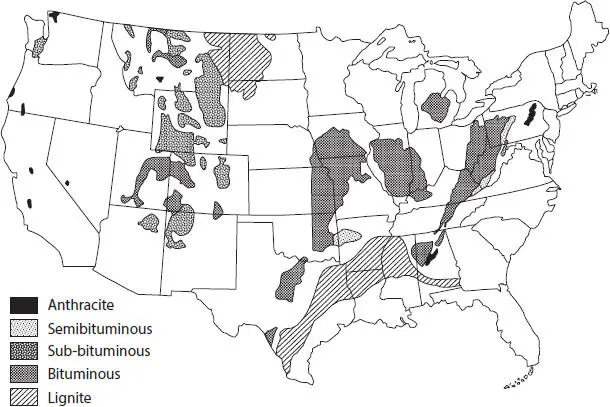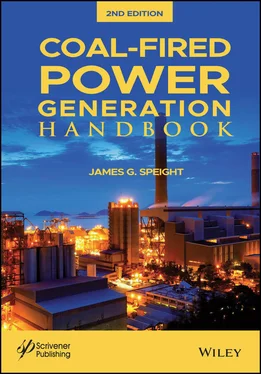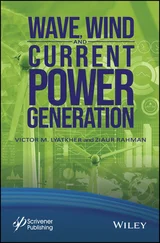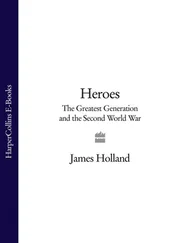Anthracite has a high fixed carbon value (80 to 95%) ( Chapters 2, 5) and a low sulfur as well as a low nitrogen (less than 1% each). Volatile matter is low at approximately 5% w/w, with 10 to 20% w/w of mineral ash produced by combustion. The moisture content is approximately 5 to 15% w/w and the coal is slow-burning and difficult to ignite because of the high density – consequently few pulverized coal-fired plants use anthracite as the fuel.
Anthracite is considered non-clinkering and free burning because (when ignited) it does not coke or expand and fuse together. It is most often burned in underfeed stoker boilers or single-retort side-dump stoker boilers with stationary grates. Dry-bottom furnaces are used because of the high ash fusion temperature of anthracite. Lower boiler loads tend to keep heat lower, which in turn reduces nitrogen oxide emissions.
Particulate matter, or fine soot, from burning anthracite can be reduced with proper furnace configurations and appropriate boiler load, under-fire air practices, and fly ash reinjection. Fabric filters, electrostatic precipitators (ESP), and scrubbers can be used to reduce particulate matter pollution from anthracite-fired boilers. Anthracite that is pulverized before burning creates more particulate matter.
Furthermore, it is worthy of note that even in the terminology of anthracite there are several variations which, although somewhat descriptive, do not give any detailed indications of the character of the coal. For example, some of the terms which refer to anthracite are: black coal, hard coal, stone coal, which should not to be confused with the German steinkohle or the Dutch steenbok , which are terms that include all varieties of coal with a stone-like hardness and appearance, blind coal, Kilkenny coal, crow coal (from its shiny black appearance), and black diamond. However, as the importance of the coal trade increased, it was realized that some more definite means of classifying coals according to their composition and heating value was desired because the lines of distinction between the varieties used in the past were not sufficiently definite for practical purposes (Thorpe et al. , 1978; Freese, 2003).
Anthracite is scarce and only a small percentage of all remaining coal resources are anthracite. Pennsylvania anthracite was mined heavily during the late 1800s and early 1900s, and remaining supplies became harder and harder to access because of their deep location. The largest quantity of anthracite ever produced in Pennsylvania was in 1917.
Historically, anthracite was mined in a 480-square-mile area in the northeastern region of Pennsylvania, primarily in Lackawanna, Luzerne, and Schuylkill counties. Smaller resources are found in Rhode Island and Virginia.
As the 21 stcentury matures, there will continue to be an increased demand for energy to support the needs of commerce industry and residential uses – in fact, as the 2040 to 2049 decade approaches, commercial and residential energy demand is expected to rise considerably – by approximately 30% over current energy demand. This increase is due, in part, to developing countries, where national economies are expanding and the move away from rural to city living is increasing. In addition, the fuel of the rural population (biomass) is giving way to the fuel of the cities (transportation fuels, electric power) as the lifestyles of the populations of developing countries change from agrarian to metropolitan. Furthermore, the increased population of the cities requires more effective public transportation systems as the rising middle class seeks private means of transportation (automobiles). As a result, fossil fuels will continue to be the predominant source of energy for at least the next 50 years.
In general terms, coal is a worldwide resource; the latest estimates, which seem to be stable within minor limits of variation (Hessley, 1990), show that there is in excess of 1,000 billion (109) tons of proven recoverable coal reserves throughout the world (Energy Information Administration, 2011). In addition, consumption patterns give coal approximately 30% or more (depending upon the source) of the energy market share (Energy Information Administration, 2011). Estimates of the total reserves of coal vary within wide limits, but there is no doubt that vast resources exist and are put to different uses (Horwitch, 1979; Hessley, 1990; EWG, 2007; Speight, 2013). However, it is reasonable to assume that, should coal form a major part of any future energy scenario, there is sufficient coal for many decades (if not hundreds of years) of use at the current consumption levels. Indeed, coal is projected as a major primary energy source for power generation for at least the next several decades and could even surpass oil in use, especially when the real costs of energy are compared to the costs of using the indigenous coal resources of the United States (Hubbard, 1991; Speight, 2020).
In order to understand the politics of coal use and production, it is necessary to put coal into the perspective of oil and gas. In the early days of the oil industry, the United States was the major producer and was predominantly an exporter of crude oil, thereby serving as the “swing” producer insofar as production was adjusted to maintain stability of world oil prices. However, oil production in the United States peaked in 1972 and has been in decline ever since and the mantle of oil power has shifted to the Middle East, leading to new political and economic realities for the world. From the 1970s, oil prices have been determined more by international affairs (geopolitics) than by global economics (Yergin, 1991).
In contrast to current US oil production and use patterns, the United States is not a significant importer of natural gas. Trade agreements with Canada and with Mexico are responsible for the import of natural gas but these are more of a convenience for the border states rather than for the nation as a whole.
In the United States, the use of coal increased after World War II with the majority of the production occurring in the eastern states close to the population centers. The majority of the recovery methods used underground mining techniques in the seams of higher quality, i.e., the minerals and water content of the coal was relatively low and the coal had a high heat-content ( Chapters 5, 6). However, by the late 1960s, natural gas and crude oil had captured most of the residential, industrial, and commercial market, leaving only power generation and metallurgical coke production as the major uses for coal.
On a global scale, the United States is a major source of coal (Figure 1.2) as well as a coal producer and coal exporter (Chadwick, 1992). There are many coal-producing states in the United States but the passage, and implementation, of the Clean Air Act in the early 1970s opened up new markets for the easily (surface) mined low-sulfur coals ( Table 1.5, Table 1.6, Figure 1.3) from the western United States and captured a substantial share of the energy (specifically, the electrical utility) markets. In addition, states such as Wyoming were the major beneficiaries of the trend to the use of low-sulfur coal and occupy a significant position in the coal reserves and coal production scenarios of the United States (Speight, 2013, 2020).

Figure 1.2Coal types and distribution in the United States.
Читать дальше













